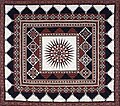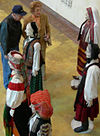
A quilt is a multi-layered textile, traditionally composed of two or more layers of fabric or fiber. Commonly three layers are used with a filler material. These layers traditionally include a woven cloth top, a layer of batting or wadding, and a woven back combined using the techniques of quilting. This is the process of sewing on the face of the fabric, and not just the edges, to combine the three layers together to reinforce the material. Stitching patterns can be a decorative element. A single piece of fabric can be used for the top of a quilt, but in many cases the top is created from smaller fabric pieces joined, or patchwork. The pattern and color of these pieces creates the design. Quilts may contain valuable historical information about their creators, "visualizing particular segments of history in tangible, textured ways".
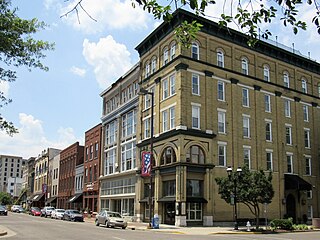
Paducah is a home rule-class city in the Upland South, and the county seat of McCracken County, Kentucky, United States. The largest city in the Jackson Purchase region, it is located in the Southeastern United States at the confluence of the Tennessee and the Ohio rivers, halfway between St. Louis, Missouri, to the northwest and Nashville, Tennessee, to the southeast. As of the 2020 census, the population was 27,137, up from 25,024 in 2010. Twenty blocks of the city's downtown have been designated as a historic district and listed on the National Register of Historic Places.
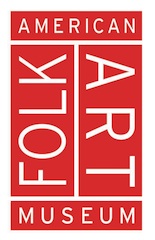
The American Folk Art Museum is an art museum in the Upper West Side of Manhattan in New York City, at 2 Lincoln Square, Columbus Avenue at 66th Street. It is the premier institution devoted to the aesthetic appreciation of folk art and creative expressions of contemporary self-taught artists from the United States and abroad.

The Genesee Country Village and Museum is a 19th-century living history museum covering more than 600 acres (2.4 km2) located in the town of Wheatland, New York, United States, in the small hamlet of Mumford, about 20 miles (32 km) from Rochester. On the museum property is the 19th-century village, the John L. Wehle Gallery of Sporting Art, the Genesee Country Nature Center, the Carriage Museum, the Silver Baseball Park and the Heirloom Gardens. The facility offers special events and classes throughout the year.
Quilt art, sometimes known as art quilting, mixed media art quilts or fiber art quilts, is an art form that uses both modern and traditional quilting techniques to create art objects. Practitioners of quilt art create it based on their experiences, imagery, and ideas, rather than traditional patterns. Quilt art is typically hung or mounted.
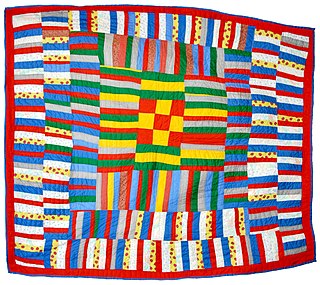
The quilts of Gee's Bend are quilts created by a group of women and their ancestors who live or have lived in the isolated African-American hamlet of Gee's Bend, Alabama along the Alabama River.

The San Jose Museum of Quilts & Textiles is an art museum in Downtown San Jose, California, USA. Founded in 1977, the museum is the first in the United States devoted solely to quilts and textiles as an art form. Holdings include a permanent collection of over 1,000 quilts, garments and ethnic textiles, emphasizing artists of the 20th- and 21st-century, and a research library with over 500 books concerning the history and techniques of the craft.
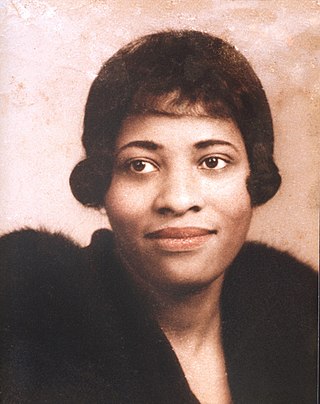
Rosie Lee Tompkins (1936–2006) is the art pseudonym of Effie Mae Martin Howard, a widely acclaimed African-American quiltmaker and fiber artist of Richmond, California. The New York Times called her "one of the great American artists," and her work "one of the century’s major artistic accomplishments." More than 500 works by Tompkins reside at the Berkeley Art Museum and Pacific Film Archive.
Michael Francis James is an American artist, educator, author, and lecturer. He is best known as a leader of the art quilt movement that began in the 1970s. He currently lives and maintains a studio in Lincoln, Nebraska.

Oceanside Museum of Art is a fine arts museum in Oceanside, California. It began holding exhibits in 1995, with a dedicated facility opening on October 6, 1997. The museum is housed in two buildings designed by Irving Gill and Frederick Fisher, modernist architects from Southern California.
Linda MacDonald was born in 1946, in Berkeley, California. She is a multimedia artist who was at the forefront of the studio quilt art movements. She has been called a "fine artist [who works] with quilting techniques."
Nancy Morrison Crow is an American art quilter and fiber artist. She is one of the leading figures in the development of the art quilting movement of the 1970s and 1980s, and is also known for her development of certain techniques to allow more spontaneity and expression.
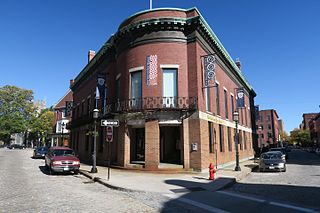
The New England Quilt Museum, founded in 1987, is located in downtown Lowell, Massachusetts and is the only institute in the Northeastern United States solely dedicated to the art and craft of quilting. It is the second-oldest quilt museum in the United States. It houses special and permanent exhibits, a library, a museum shop, and classrooms. Collections are strong in 19th century quilts, with a geographic focus on New England.

Jean Ray Laury was an American artist and designer. She was one of the first fine artists to move to quilting as a medium of choice in the late 1950s. Her quilts followed neither traditional method nor pattern; they were bold, modern, colorful collages, often laced with humor and satire. Penning over twenty books and teaching over 2,000 workshops, Laury helped women see the creative possibilities in everyday objects and awake their sense of inspiration. Laury has been called a "foremother of a quilt revival", and "one of the pioneers" of non-traditional quilts.
Martha Neill Upton was a watercolorist, sculptor and studio quilt artist. Her quilted tapestries helped quilts become seen as fine art, rather than craft work, during the early 1970s. Her quilts were shown in the first major museum exhibition of non-traditional quilts, The New American Quilt at New York's Museum of Arts and Design, then called the Museum of Contemporary Craft, in 1976.
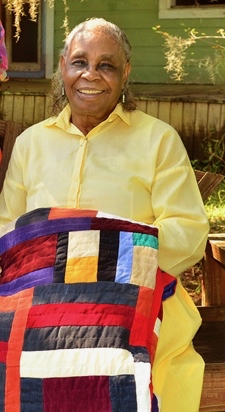
Mary Lee Bendolph is an American quilt maker of the Gee's Bend Collective from Gee's Bend (Boykin), Alabama. Her work has been influential on subsequent quilters and artists and her quilts have been exhibited in museums and galleries around the country. Bendolph uses fabric from used clothing for quilting in appreciation of the "love and spirit" with old cloth. Bendolph has spent her life in Gee's Bend and has had work featured in the Philadelphia Museum of Art as well as the Minneapolis Institute of Art in Minnesota.
Bisa Butler is an American fiber artist who has created a new genre of quilting that has transformed the medium. Although quilting has long been considered a craft, her interdisciplinary methods—which create quilts that look like paintings—have catapulted quilting into the field of fine art. She is known for her vibrant, quilted portraits celebrating Black life, portraying both everyday people and notable historical figures. Her works now count among the permanent collections at the Smithsonian National Museum of African American History and Culture, the Art Institute of Chicago, Pérez Art Museum Miami and about a dozen other art museums nationwide. She has also exhibited at the Smithsonian Museum of American History, the Epcot Center, the National Underground Railroad Freedom Center, and many other venues. In 2020, she was commissioned to quilt cover images for Time magazine, including the "Person of the Year" issue and its "100 Women of the Year" issue. With a multi-year wait list for private commissions, one of Butler's quilts sold at auction in 2021 for $75,000 USD.
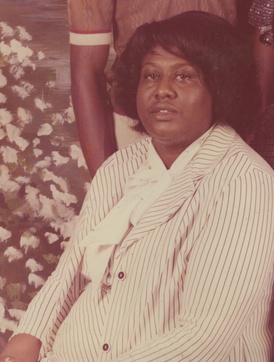
Nellie Mae Abrams (1946–2005) was an American artist. She is associated with the Gee's Bend quilting collective. Her art has been exhibited at the Museum of Fine Arts, Houston and the Gund Gallery at Kenyon College, and is included in the collection of the Minneapolis Institute of Art and the Philadelphia Museum of Art. She was the daughter of Annie Mae Young, who was also a quiltmaker.
Joan Schulze is an American artist, lecturer, and poet. Schulze's career spans over five decades: she is best known for her work of contemporary quilts, fiberarts, and collage. Schulze has been named a “pioneer of the art quilt movement,” and her influence has been compared to that of Robert Rauschenberg’s. Her work is in galleries and private collections worldwide including the Renwick Gallery/Smithsonian Institution in Washington DC, the Museum of Arts and Design in New York, & the Oakland Museum of California.
Objects: USA (1969) was a groundbreaking exhibition considered a watershed in the history of the American studio craft movement. It "blurred lines between art and craft, artist and artisan". The exhibition featured a survey collection of craft works by artists from across the United States. Artists were approached and works chosen by New York gallery owner Lee Nordness and curator Paul J. Smith, the director of the Museum of Contemporary Crafts. The exhibition was funded by S. C. Johnson & Son, which purchased the pieces for the exhibition and later donated many of them to American museums. The Objects: USA exhibition appeared at thirty-three locations in the United States and Europe. The accompanying exhibition catalog Objects: USA (1970) became a classic reference work.














